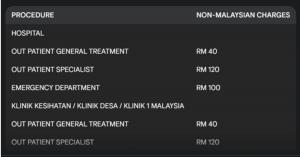Malaysia’s Dual Healthcare System- A Call for Balanced Policy Amidst Price Scrutiny
In response to recent public discussions surrounding healthcare pricing and pharmacy price labelling in Malaysia, Dr. Chang Chee Seong, a prominent voice in the nation's healthcare discourse, today issued a statement emphasising the critical balance of Malaysia’s bifurcated healthcare system. The statement advocates for a comprehensive, data-driven approach to reforms that respects the integral roles of both the public backbone and the private engine.
Malaysia's healthcare system is lauded for its unique duality: a publicly funded sector providing near-universal, highly subsidised access, and a market-driven private sector offering choice, speed, and personalised care. This equilibrium has historically ensured healthcare equity while simultaneously alleviating the burden on public facilities.
"For millions of Malaysians, the public healthcare system is an essential lifeline, offering consultations for as little as RM1.00 at Klinik Kesihatan and RM5.00 for outpatient specialist visits at public hospitals," Dr. Chang highlights. "This widespread affordability underscores the significant government subsidy extended to citizens, a matter that deserves greater transparency and public engagement regarding its scale, allocation, and long-term sustainability."
In contrast, the private sector, fuelled by out-of-pocket payments and private insurance, has evolved to deliver world-class clinical care, becoming a cornerstone of Malaysia's burgeoning medical tourism industry. In 2023, medical tourism generated an estimated RM2.25 billion, with forecasts aiming for RM2.8 billion by 2025, largely due to excellent clinical outcomes, modern infrastructure, and competitive costs.
However, recent increased intervention from government ministries, framed as "price transparency," has raised concerns within the private healthcare sector. "It is questionable why a market-funded, unsubsidised system is being regulated as though it were part of the public sector," states Dr. Chang. "Rather than reducing costs, such regulations risk inflating operational overheads, which are inevitably passed on to patients. More significantly, they risk undermining the innovation and service quality that have made the private sector – and by extension, medical tourism – a Malaysian success story."
The push for "transparency," Dr. Chang observes, appears selectively applied. "If the Ministry of Health is genuinely committed to systemic transparency, why does scrutiny begin and end with private clinics and hospitals?" he questions. "There are concerns about transparency in pharmaceutical pricing structures, insurance and third-party administration (TPA) practices, and back charges and rebates embedded within the supply chain. If pricing reform is to be equitable and meaningful, it must start at the source, not at the end of the value chain."
The statement also raises critical questions for policymakers: Is the private healthcare sector being targeted to justify a national health financing scheme? Is Malaysia ready for dispensing separation and mandatory national health financing, potentially imposing a new statutory deduction on working Malaysians?
"The overarching principle is that transparency should not be a tool of convenience, wielded selectively. It must be holistic, inclusive, and fair across the board," Dr. Chang asserts.
Dr. Chang concludes by urging policymakers to adopt a data-driven, inclusive approach that respects the vital roles played by both sectors. "Unbalanced regulation threatens not only to weaken the private sector but also to undermine Malaysia’s global healthcare reputation. Any reforms must strengthen the system as a whole and avoid dismantling what already functions effectively."
Chang Chee Seong
PMPASKL
+60 16-446 5126
changcs88|gmail.com| |changcs88|gmail.com
Legal Disclaimer:
EIN Presswire provides this news content "as is" without warranty of any kind. We do not accept any responsibility or liability for the accuracy, content, images, videos, licenses, completeness, legality, or reliability of the information contained in this article. If you have any complaints or copyright issues related to this article, kindly contact the author above.
VitalPBX Launches Native Odoo CRM Integration to Boost Unified Business Workflows
Civil Engineering Services Drive Results For Growing Real Estate Firms
Wealth Factory Launches Financial Services Platform Designed Exclusively for Entrepreneurs and Small Business Owners
Więcej ważnych informacji
 Jedynka Newserii
Jedynka Newserii

 Jedynka Newserii
Jedynka Newserii

Polityka

D. Joński: Nie wiemy, co zrobi Rosja za dwa–trzy lata. Według duńskiego wywiadu może zaatakować kraje nadbałtyckie i musimy być na to gotowi
Zdecydowana większość krajów unijnych wskazuje na potrzebę wzmocnienia zdolności obronnych Europy w obliczu coraz bardziej złożonego geopolitycznego tła. Wywiady zachodnich państw wskazują, że Rosja może rozpocząć konfrontację z NATO jeszcze przed 2030 rokiem. Biała księga w sprawie obronności europejskiej „Gotowość 2030” zakłada m.in. ochronę granic lądowych, powietrznych i morskich UE, a sztandarowym projektem ma być Tarcza Wschód. – W budzeniu Europy duże zasługi ma polska prezydencja – ocenia europoseł Dariusz Joński.
Transport
Duże magazyny energii przyspieszą rozwój transportu niskoemisyjnego w Europie. Przyszłością może być wodór służący jako paliwo i nośnik energii

Zmiany w europejskim transporcie przyspieszają. Trendem jest elektromobilność, zwłaszcza w ramach logistyki „ostatniej mili”. Jednocześnie jednak udział samochodów w pełni elektrycznych w polskich firmach spadł z 18 do 12 proc., co wpisuje się w szerszy europejski trend spowolnienia elektromobilności. Główne bariery to ograniczona liczba publicznych stacji ładowania, wysoka cena pojazdów i brak dostępu do odpowiedniej infrastruktury. – Potrzebne są odpowiednio duże magazyny taniej energii. Przyszłością przede wszystkim jest wodór – ocenia Andrzej Gemra z Renault Group.
Infrastruktura
W Polsce w obiektach zabytkowych wciąż brakuje nowoczesnych rozwiązań przeciwpożarowych. Potrzebna jest większa elastyczność w stosowaniu przepisów

Pogodzenie interesów konserwatorów, projektantów, inwestorów, rzeczoznawców i służby ochrony pożarowej stanowi jedno z największych wyzwań w zakresie ochrony przeciwpożarowej obiektów konserwatorskich. Pożary zabytków takich jak m.in. katedra Notre-Dame w Paryżu przyczyniają się do wprowadzania nowatorskich rozwiązań technicznych w zakresie ochrony przeciwpożarowej. W Polsce obowiązuje już konieczność instalacji systemów detekcji. Inwestorzy często jednak rezygnują z realizacji projektów dotyczących obiektów zabytkowych z uwagi na zmieniające się i coraz bardziej restrykcyjne przepisy czy też względy ekonomiczne.
Partner serwisu
Szkolenia

Akademia Newserii
Akademia Newserii to projekt, w ramach którego najlepsi polscy dziennikarze biznesowi, giełdowi oraz lifestylowi, a także szkoleniowcy z wieloletnim doświadczeniem dzielą się swoją wiedzą nt. pracy z mediami.





![Nestlé w Polsce podsumowuje wpływ na krajową gospodarkę. Firma wygenerowała 0,6 proc. polskiego PKB [DEPESZA]](https://www.newseria.pl/files/1097841585/fabryka-nesquik_1,w_85,r_png,_small.png)




.gif)

 |
| |
| |
|